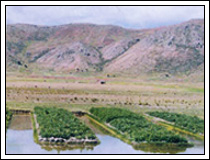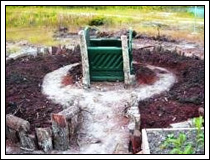Raised Beds And Waru Waru Cultivation
Raised beds and waru waru cultivation is an ancient soil management system that dates back to to the year 300 BC. It employs raised beds along with proper irrigation channels to prevent damage to crops due to soil erosion during floods. Concentrating mainly on facilitating water movement and storage, this technology increases the organic content of the soil thereby making it more suitable and fertile.

Technical Description
Raised beds and waru waru cultivation involves the management of a number of things like:
- Rehabilitation of marginal soils
- Drainage improvement
- Water storage
- Optimal utilization of available radiant energy
- Attenuation of the effects of frost.
The technology involves construction of network of embankments and canals, where the crops are cultivated and water is stored for irrigating the plants. Only compacted soils are used to build the raised beds or embankments because such soil maintains water retention by reducing porosity, permeability, and infiltration.
Cultivation is done on the "new" soil of the raised beds, where an increased porosity is maintained, so the new soils further enhances infiltration, often increasing infiltration by 80% to 100% of the original soil. Surprisingly, raised beds permit the recycling of nutrients and all the other chemical and biological processes necessary for crop production. They take up the water through diffusion and capillary movement and maintains an adequate moisture level in the soil, so that thermal energy gets captured and retained in the soil. This protects the soils of the bed from the effects of frost and facilitates the cultivation of plants such as potatoes and quinoa (Chenopodium quinoa). The complete system acts as a thermoregulator of the microclimate within the bed.
Types of Raised Beds :
There are three types of raised bed systems which are characterized by the source of water:
Rainwater systems : In this system rainwater used as is the primary source of moisture. During dry seasons, the water is stored in small lagoons, from where it is passed to the canals and then to the raised beds. Raised beds using rainwater are usually seen to be located at the base of hills or a mountains.
Fluvial systems: In fluvial systems, the water supplied to the raised beds is procured from nearby rivers or streams by using hydraulic powered canals or dikes are used.

Phreatic systems: In this system, the underground water is used to maintain the moisture of the soil in the raised beds. These systems are possible only in places where the groundwater table is close to the surface of the soil. Infiltration lagoons are used for recharging the groundwater.
Advantages Of Raised beds
Although, in contemporary times, we have a wide range of advanced technology of irrigation and soil management, raised beds and waru waru cultivation are still under practice in some areas; this is because the system boasts of many unmatched advantages like :
Effects of extreme climatic variations can be mitigated using this technology
The construction is quite simple and cost involved in setting up the system is relatively low.
It can increase the production of certain agricultural crops.
Disadvantages
There are certain setbacks of this technology, which are listed below :
- The durability of the system is relatively short
- It requires maintenance and re reconstruction after about 3 years of operation.
- Testing of soil texture and composition is necessary before implementation.
|